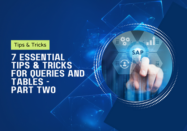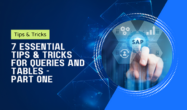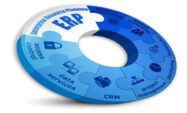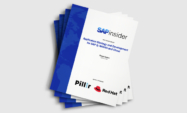SAP Application Development and Integration
SAP ABAP | SAP ABAP Development Tools | SAP ABAP Test Cockpit | SAP API Management | SAP BAPI | SAP Basis | SAP BRF | SAP Business Application Studio | SAP CMS | SAP Design Studio | SAP Development Tools | SAP DevOps | SAP EAI | SAP EDI | SAP Extension Suite | SAP Fiori | SAP Fiori Elements | SAP Integration Suite | SAP Low Code Application Development | SAP Low Code Automation | SAP Netweaver | SAP Release Management | SAP UI5 | SAP Web Application Server | SAP Web IDE
Filter By
Browse By
- SAP Analytics and AI
- SAP Application Development and Integration
- All SAP Application Development and Integration
- SAP ABAP
- SAP ABAP Development Tools
- SAP ABAP Test Cockpit
- SAP API Management
- SAP BAPI
- SAP Basis
- SAP BRF
- SAP Business Application Studio
- SAP CMS
- SAP Design Studio
- SAP Development Tools
- SAP DevOps
- SAP EAI
- SAP EDI
- SAP Extension Suite
- SAP Fiori
- SAP Fiori Elements
- SAP Integration Suite
- SAP Low Code Application Development
- SAP Low Code Automation
- SAP Netweaver
- SAP Release Management
- SAP UI5
- SAP Web Application Server
- SAP Web IDE
- SAP Business Process Management
- SAP Center of Excellence
- SAP CIO
- SAP Customer Experience
- SAP Data and Data Management
- All SAP Data and Data Management
- SAP BW
- SAP BW/4HANA
- SAP Crystal Reporting
- SAP Data Archiving
- SAP Data Center
- SAP Data Governance
- SAP Data Integration
- SAP Data Migration
- SAP Data Quality
- SAP Data Services
- SAP Data Strategy
- SAP Data Visualization
- SAP Data Warehouse Cloud
- SAP DMS
- SAP Document Control
- SAP EIM
- SAP ETL
- SAP ETL Tools
- SAP HANA
- SAP HANA Administration
- SAP HANA Deployment Infrastructure
- SAP HANA Studio
- SAP Master Data
- SAP Master Data Governance
- SAP MDM
- SAP Enterprise Architect
- SAP Enterprise Asset Management
- SAP ERP
- SAP Finance
- All SAP Finance
- SAP Accounting
- SAP AR AP
- SAP Asset Accounting
- SAP Billing Systems
- SAP BPC
- SAP BRIM
- SAP Cash Management
- SAP Central Finance
- SAP Controlling
- SAP COPA
- SAP Cost Center Accounting
- SAP e-invoicing
- SAP FICO
- SAP Finance Automation
- SAP Financial Closing Cockpit
- SAP Financial Consolidation
- SAP Financial Planning
- SAP FX Risk
- SAP General Ledger
- SAP Global Tax Management
- SAP Hyperion
- SAP Order to Cash
- SAP Payment Processing
- SAP Profitability Analysis
- SAP Rebate Management
- SAP S/4HANA Finance
- SAP Universal Journal
- SAP Governance Risk and Compliance
- SAP Human Capital Management
- SAP Intelligent Technologies
- SAP Platform and Technology
- All SAP Platform and Technology
- SAP Business Technology Platform
- SAP Cloud Connector
- SAP Cloud Integration Platform
- SAP Cloud Migration
- SAP Cloud Platform
- SAP Cloud Providers
- SAP Cloud Strategy
- SAP Container Platform
- SAP Digital Asset Management
- SAP Digital Integration Hub
- SAP Digital Signature
- SAP HANA Enterprise Cloud
- SAP HEC
- SAP Hyperscalers
- SAP Infrastructure
- SAP Messaging
- SAP Smart Forms
- SAP Quality and Testing
- SAP Security
- SAP Spend Management
- SAP Supply Chain Management
- All SAP Supply Chain Management
- SAP APO
- SAP Asset Management
- SAP Business Network
- SAP Digital Manufacturing Cloud
- SAP Digital Twin
- SAP EWM
- SAP IBP
- SAP Inventory Management
- SAP Label Printing
- SAP Logistics
- SAP Manufacturing
- SAP Manufacturing Automation
- SAP MES
- SAP MII
- SAP MM
- SAP MRO
- SAP MRP
- SAP Order Management
- SAP Plant Maintenance
- SAP PLM
- SAP Production Planning
- SAP S&OP
- SAP SD
- SAP SPM
- SAP Supply Chain Planning
- SAP Track and Trace
- SAP Transportation Management
- SAP System Administration
SAP Application Development and Integration
For success and for even survival, today’s companies must develop and roll out applications, with high quality, user experience, and integration, while minimizing risks associated with the rapid development and deployment of applications.
SAP Application Development and Integration
For success and for even survival, today’s companies must develop and roll out applications, with high quality, user experience, and integration, while minimizing risks associated with the rapid development and deployment of applications.
SAPinsider’s benchmark report on Application Strategies and Development for SAP S/4HANA and Cloud discovered that found that the top driver for application strategy is the need to maintain or improve business processes rapidly to support changing needs (50%). The next important driver is the continued demand for SAP and non-SAP applications that connect to core SAP (36%).
Understanding this burgeoning need for developing applications, SAP has bundled several tools in the SAP Extension Suite and SAP Integration Suite which are part of the SAP Business Technology Platform (SAP BTP).
To deliver the value proposition, SAP Extension Suite includes components such as SAP AppGyver for low-code development, SAP Business Application Studio for extending business applications, SAP Conversational AI for voice and bot applications, SAP Mobile Development Kit (MDK) for mobile applications, SAP native SDKs for iOS and Android as well as the SAP Fiori design system and design platform for pre-built common applications for thousands of use cases.
This valuable article Extend Your Core Business Applications and Drive Your Business Forward with SAP Extension Suite outlines the various ways in which SAP Extension Suite provides extensibility and walks through the various steps in the process of utilizing it.
ABAP code forms the bulk of the legacy customizations and extensions. As part of SAP BTP, ABAP environments provide ways to develop using the ABAP RESTful Application Programming Model (RAP), leveraging SAP HANA, SAP Fiori, and a cloud-optimized ABAP language with a clear set of released standard APIs. Developers can utilize a development toolset that enables tight integration with Git-enabled lifecycle management that includes ABAP ABAP editors, dictionary, UI painters, function, class, and web app builders.
Skills are always a major issue in development as the above-mentioned report found. SAP Extension Suite offers options of different technologies and programming languages through various options and runtime environments are available on the SAP BTP: ABAP environment, Cloud Foundry runtime, and Kyma runtime.
Almost half of the respondents in SAPinsider research on Application Strategies and Development for SAP S/4HANA and Cloud are planning or evaluating low-code platforms. There is an expectation of significant impact from these platforms such as ability to deliver applications rapidly, reduced IT costs, and enabling industry standards. Read the article “Governance for Low-code Platforms” on recommendations on governance for low-code platforms.
There is an exciting range of applications that are possible in today’s platforms. Companies like ServiceNow and Pillir.io provide a significant set of prebuilt apps in their low-code platforms. Consultants such as Cognizant, cbs Consulting, Capgemini, and TechMahindra can provide the expertise to drive innovation.
What is SAP Integration?
Establishing a single hub of information is vital to arm business leaders at any organization with the real-time information they need to make the decisions that will benefit their organization the most. While IT teams can manually create some connections, integration platforms are often favored as the solutions to keep all facets of the business connected.
These platforms have significant experience in ensuring that data flows throughout the business to the appropriate points while remaining accurate, accessible, and up-to-date. Organizations should ensure that they keep integration in mind when incorporating new applications and systems into their overall SAP landscape.
Organizations should ensure that all solutions they adopt can become part of a consistent software architecture that will accommodate any changes to business processes, new applications, and technological upgrades.
Some business processes require SAP to connect with multiple systems that communicate with SAP in slightly different ways. These systems can function together, as long as the company is able to find an integration layer that goes in between SAP and these systems, allowing the data to flow freely around the entire SAP landscape.
Why is SAP integration important?
SAP integration is vital for organizations across all industries. Nearly half a million organizations use SAP. Their reach extends to more than three quarters of all transactions between business and customers around the world. The massive scope of SAP powers global commerce. To make the most of this scale, organizations must integrate their SAP software and applications to the rest of their system, including their ERP.
Many organizations are turning more towards Software as a Service (SaaS) applications such as Salesforce to help manage business processes. Companies should be aware that the mixture of on-premise and cloud applications can pose a challenge for integrations, and factor that potential issue into any decisions made about which solutions or services they decide to leverage.
SAP Application Integration: Use Cases
Integration is important for all SAP applications to pair with non-SAP applications. Yet there are certain specific scenarios, systems, applications, and functions in which SAP integration is most common. These scenarios are:
CRM applications: Customer Relationship Management is one of the most vital functions of a consumer-facing business. As such, organizations must ensure that they have tight integration between their CRM systems and their ERP systems. Ensuring that customer data is consistent can help avoid improve overall business agility. To do this, organizations need to have a consistent pipeline of information between CRM systems and ERP systems so that financial, performance, and other business data is easily accessible from all parts of the business.
Supplier systems: Just as businesses must have accurate and up-to-date information for their customers, they must also have that same data for vendors. Staying on top of purchase requests, ensuring that all potential suppliers know what raw materials a business needs, and having a single source of truth for all quotes keeps all financial information accurate and ensures continuity through the supply side of the business.
Third party purchase order systems: While it is important to integrate all applications within ones own business, it is also important to set up a system to communicate with partners, such as third parties who operate purchase order systems. Integrating with these valuable organizations can help streamline new purchase orders, automatically enabling businesses to buy necessary materials while keeping all facets of the organization up to date on the process.
Join SAPinsider to access opportunities for networking and engagement in the dynamic SAP ecosystem. As a member, you will have access to a wealth of valuable resources and content tailored to SAP technologies and best practices like the latest research reports, articles, webinars, and events that will keep you informed and ahead of the curve.SAPinsider membership grants you exclusive access to in-depth analyses, expert insights, and practical guidance that will empower you to navigate the ever-evolving SAP landscape with ease. SAPinsider membership will enable you to remain one step ahead and harness the latest trends, innovations, and strategies to drive your own powerful digital transformations, optimize your SAP investments, and unlock business success.
45 results
-

Using CxLink for SAP Data and Applications on AWS
October 13, 2022
There are SAP applications everywhere and in various organizations. Some reside on-premises while others are cloud-based. Databases and documents are everywhere and are very siloed. This webinar presents options for breaking down those siloes using CxLink for SAP data and applications on AWS. Join us to learn how creating integrated and innovative views of your…
-

Seven Essential Tips and Tricks for Queries and Tables – Part Two
Reading time: 5 mins
Get tips and tricks that will make your day easier and faster in SAP. Learn how to create your own queries, find specific tables, and convert spool requests into PDF files automatically. Part 2 This content is for Basic Access, SAPinsider Monthly Subscription, SAPinsider Annual Subscription, and SAPinsider Premium Annual Subscription members only.Log In Join…
-

Seven Essential Tips and Tricks for Queries and Tables – Part One
Reading time: 4 mins
Get tips and tricks that will make your day easier and faster in SAP. Learn how to create your own queries, find specific tables, and convert spool requests into PDF files automatically. This content is for Basic Access, SAPinsider Monthly Subscription, SAPinsider Annual Subscription, and SAPinsider Premium Annual Subscription members only.Log In Join Now
-
-

Integration in the Hyper-connected SAP Landscape – Research Report
Reading time: 1 mins
Integration in the Hyper-connected SAP Landscape In this report we will discuss integration in the hyper-connected SAP Landscape. SAP landscapes are today, far from monoliths. They are hyper-integrated with a host of applications to SAP to enable seamless business processes and enterprise analytics. This is a colossal task considering the need to integrate with legacy…
-

Achieving the “Clean Core” Utopia
Reading time: 2 mins
SAP teams have been chasing the “clean core” utopia for decades. Yet, they have not only missed reaching it, but often have also made the scenario worse. SAP customers have often invested heavily in customization, and this has resulted in massive custom code, often with clunky interfaces and limited documentation. Yet, there is significant risk…...…
-

Governance for Low-code Platforms
Reading time: 3 mins
Low-code governance is about making decisions with consistent, structured criteria to rollout low-code apps to support IT in delivering business goals, so that they generate business value with minimum risks. This content is for Basic Access, SAPinsider Monthly Subscription, SAPinsider Annual Subscription, and SAPinsider Premium Annual Subscription members only.Log In Join Now
-

Application Strategy and Development for SAP S/4HANA and Cloud Research Webinar
March 10, 2022
On Demand With digital transformation initiatives maturing and the market presenting an increasing range of new software solutions, IT departments are developing sophisticated application strategies and roadmaps to deliver quality applications rapidly without blowing up budgets. For SAP customers, the critical challenge is how they can monetize their past SAP investments while rapidly deploying applications that…
-
-

How the automation of SAP infrastructure increases operational efficiency and makes room for innovation
Automation is critical to managing the way your SAP business operates. By simplifying change through automation, you gain time and energy to focus on innovation. Register to watch this informative video hosted by Red Hat.
-

Master Data Management Best Practices to Maximize Value From Your SAP Deployment
March 01, 2022
Ensuring you have trusted, reconciled, and consistent data across both SAP and non-SAP systems is critical in support of various business processes, applications, and insights. Increasingly, organizations are adopting master data management (MDM) to ensure the integrity of their business processes. However, launching and managing a MDM initiative can be a demanding and complex project. Join…
-

Application Strategy and Development for SAP S/4HANA and Cloud Research
Reading time: 1 mins
In This Report: With digital transformation initiatives maturing and the market presenting an increasing range of new software solutions, IT departments are developing sophisticated application strategies and roadmaps to deliver quality applications rapidly without blowing up budgets. For SAP customers, the critical challenge is how they can monetize their past SAP investments while rapidly deploying…
Featured Insiders
-

Lars Hvam
Heliconia Labs, ABAP Expert
-

Martin Hastik
Mycronix GmbH&CoKG, Managing Director
-

Daniil Serebrennikov
VTM Software Inc
Become a Member
Unlimited access to thousands of resources for SAP-specific expertise that can only be found here.
Upcoming Events
Related Vendors
Your request has been successfully sent

